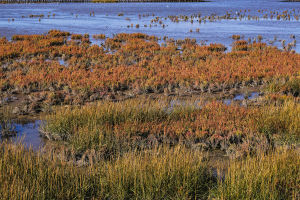Mangroves are extraordinary trees that thrive along tropical and subtropical coastlines.
Beyond their scenic beauty, they serve as essential protectors of shorelines, reducing erosion, buffering communities from storm surges, and sustaining diverse ecosystems.
Their complex root structures stabilize sediments, slow tidal currents, and trap nutrients, making them a critical part of coastal resilience. With climate change driving sea-level rise and increasing the frequency of extreme weather events, understanding the role of mangroves in coastal protection is more important than ever.
Physical Barrier Against Erosion
One of the primary functions of mangroves is preventing shoreline erosion. Their dense root networks, including prop roots and pneumatophores, trap sediments carried by tidal waters. This process gradually builds up the soil, forming natural embankments that protect inland areas.
Red mangroves, in particular, extend long prop roots into the water, creating a mesh that slows water movement and allows fine particles to settle. Over decades, these accumulations can form new landforms, reinforcing the coastline. In areas lacking mangroves, erosion can proceed rapidly, leaving communities and habitats vulnerable to land loss.
Storm Surge Mitigation
Mangroves act as natural buffers during storms, hurricanes, and cyclones. Their trunks and intricate root systems absorb and dissipate the energy of incoming waves, reducing the height and force of storm surges that reach inland areas. Observational studies indicate that communities with dense mangrove forests experience substantially lower flood damage compared to those in deforested zones.
Furthermore, the flexible stems of mangrove trees bend under strong winds rather than break, providing additional protection to both human settlements and coastal infrastructure.
Wave and Tide Energy Reduction
Mangroves also moderate daily tidal and wave energy, preventing the scouring of beaches and estuaries. The slowed water movement encourages sediment deposition, which gradually raises land levels and enhances natural flood defenses.
In low-lying regions, this accumulation is particularly important, as even minor erosion or tidal surges can threaten habitats, crops, and infrastructure. By reducing the erosive power of tides and waves, mangroves create a more stable and resilient coastal environment over time.
Supporting Biodiversity and Ecosystem Services
Mangrove forests are biodiversity hotspots. They serve as nurseries for fish, shrimp, and other aquatic species, supporting local fisheries and livelihoods. Birds, amphibians, and insects rely on mangroves for shelter, breeding, and food. Beyond wildlife, mangroves filter sediments and pollutants from water, improving water quality and protecting nearby coral reefs and seagrass beds.
Healthy mangrove ecosystems maintain ecological balance and enhance the resilience of coastlines by preserving habitats and reducing environmental stressors.
Carbon absorption and Climate Adaptation
Mangroves are highly efficient carbon sinks. They store significant amounts of CO₂ in their biomass and underlying sediments, mitigating climate change while strengthening soil stability. Carbon-rich soils improve water retention and enhance the coast's ability to withstand rising sea levels and storm events.
The combination of sediment stabilization, biodiversity support, and carbon absorption makes mangroves a multifaceted defense system that protects both human communities and natural ecosystems.
Human Impact and Conservation
Despite their critical role, mangroves face threats from urban development, aquaculture, and deforestation. Removing mangrove forests increases vulnerability to flooding, accelerates erosion, and reduces biodiversity. Conservation efforts such as reforestation, sustainable management, and the creation of protected areas are essential.
Communities that invest in mangrove protection often experience reduced flood damage, improved fisheries, and stronger ecosystem services, highlighting both ecological and economic benefits.
Conclusion: Nature's Ingenious Defense
Mangroves exemplify nature's ingenuity in coastal protection. Through sediment stabilization, wave dissipation, storm buffering, biodiversity support, and carbon absorbing, they safeguard both land and life. Preserving and restoring mangrove forests is a practical and sustainable strategy for climate adaptation and coastal resilience.
These resilient trees demonstrate that some of the most effective solutions to environmental challenges already exist in nature, offering lessons for sustainable human coexistence with coastal ecosystems.

